A New Interpretation of the Dendera Zodiac
[The following extract is taken from ‘Babylonian Star-Lore, An Illustrated Guide to the Star-lore and Constellations of Ancient Babylonia’ by Gavin White]
After the death of Alexander the Great in 323 BCE, the throne of Egypt passed to one of his generals, Ptolemy, who became the eponymous founder of the Ptolemaic dynasty. For the next 300 years this Greek dynasty ruled Egypt implanting many aspects of Hellenic culture in the fertile ground of this ancient civilisation. During this period two significant astronomic monuments were created at the temple of Hathor in Dendera, Upper Egypt. They are known as the Square and Circular Zodiacs – both somewhat inaccurate titles as they are actually star-maps covering a much greater range than the 12 constellations of the zodiac.
Since their rediscovery by western scholars, the Dendera Zodiacs have been compared to the Greek star-map, not only to determine the locations of the Dendera figures, but also in light of the hypothesis that any constellation figures occurring in both Greek and Egyptian star-maps must ultimately represent elements inherited from Babylonian tradition. Only three constellations beyond the zodiac figures are easily recognised as occurring in both Greek and Dendera star-maps – the serpent and raven positioned close to Leo, and the fish swimming in Aquarius’ outflow. The conclusion generated by this argument is that Babylonian influence on the Greek and Egyptian star-maps is negligible beyond the transmission of the zodiac constellations and a handful of stars closely associated with them. Another inference naturally follows from this conclusion – that the majority of Greek and Egyptian constellation figures were either created within their own independent native traditions or have been inherited from non-Babylonian sources.
Needless to say, the flaws inherent in these arguments are quite apparent – as the Greek star-map could easily contain any number of Babylonian figures that don’t appear on the Dendera Zodiacs and vice versa. It is now time to start reassessing the evidence by comparing the Greek and Egyptian star maps with what we know of the Babylonian constellation figures.
Before venturing into virgin territory it is a good idea to briefly return to the zodiac, and to the figures of Sagittarius, Virgo and Pisces in particular.
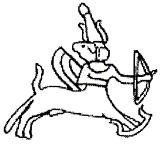 Apart from the Egyptian headdress, the depiction of Sagittarius is almost identical to its Babylonian prototype (see fig 98) even down to its two heads and two tails. What is more, below his front feet is a small figure of a boat – this can only be an image of the Babylonian Cargo-boat, which is said to be located beneath the figure of Pabilsag, the Babylonian name for our familiar Sagittarius.
Apart from the Egyptian headdress, the depiction of Sagittarius is almost identical to its Babylonian prototype (see fig 98) even down to its two heads and two tails. What is more, below his front feet is a small figure of a boat – this can only be an image of the Babylonian Cargo-boat, which is said to be located beneath the figure of Pabilsag, the Babylonian name for our familiar Sagittarius.
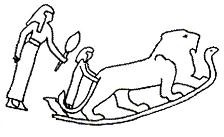 Similarly, the figure of Virgo from the Dendera Zodiac is much closer, in terms of its size and orientation, to its Babylonian prototype (see fig 160) than it is to its Greek counterpart. In addition, there is a second goddess stationed at the tail of Leo and this is very likely to be an image of the Babylonian constellation called the Frond of Erua, which is said to stand at the tail of the Lion.
Similarly, the figure of Virgo from the Dendera Zodiac is much closer, in terms of its size and orientation, to its Babylonian prototype (see fig 160) than it is to its Greek counterpart. In addition, there is a second goddess stationed at the tail of Leo and this is very likely to be an image of the Babylonian constellation called the Frond of Erua, which is said to stand at the tail of the Lion.
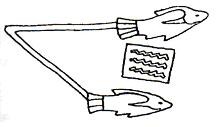 Finally, the square enclosure that can be seen between the Piscean fish is, in all likelihood, a depiction of the Field constellation that is known to correspond to the Square of Pegasus. As its name suggests, the Field represents a rectangular plot of irrigated land, which is inscribed with zigzag lines representing irrigation channels filled with water.
Finally, the square enclosure that can be seen between the Piscean fish is, in all likelihood, a depiction of the Field constellation that is known to correspond to the Square of Pegasus. As its name suggests, the Field represents a rectangular plot of irrigated land, which is inscribed with zigzag lines representing irrigation channels filled with water.
The examples illustrated above establish two significant facts. Firstly, that the designer of the Dendera Zodiac had some direct knowledge of the Babylonian forms of the zodiac. And secondly, that they also had some knowledge of less well known Babylonian constellations such as the Field, the Frond of Erua and the Cargo-boat, none of which were actually transmitted to the Greek star-map.
This last point further raises the obvious question – are there other figures from the Dendera Zodiac that represent previously unrecognised depictions of Babylonian constellations?
Personally, I am convinced that there are many more parallels between the Dendera figures and the Babylonian constellations, and that they are especially evident in the sequence of southern constellations that stretch between the figures of Taurus and Scorpio. It is well worthwhile comparing these particular Dendera figures with what is known concerning their potential Babylonian counterparts.
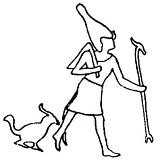 The Egyptian figure corresponding to Orion is called Sah, the ‘Fleet-footed’ or ‘Long-strider’, presumably because he is portrayed in a walking posture. He is first depicted in Egyptian astronomic documents dating to the last centuries of the 3rd millennium. On the Dendera Zodiac (left) a crested bird can be seen walking behind him.
The Egyptian figure corresponding to Orion is called Sah, the ‘Fleet-footed’ or ‘Long-strider’, presumably because he is portrayed in a walking posture. He is first depicted in Egyptian astronomic documents dating to the last centuries of the 3rd millennium. On the Dendera Zodiac (left) a crested bird can be seen walking behind him.
The Babylonian version of Orion is called the True Shepherd of Anu. Although no depictions are known, it is likely that he was portrayed as the messenger to the gods known as Ninšubur or Papšukkal. Star names indicate that he was posed as if walking with one foot and hand extended before him. His symbol of office was a long staff and on entitlement stones he was frequently represented by the figure of a crested walking bird (see fig 112). On the Babylonian star-map this bird is characterised as the Rooster, which is located below and behind the figure of the True Shepherd. That the figure of Orion should be envisioned in the form of a walking man is no particular surprise given the configuration of stars, but the common association with a walking bird with a crest on its head must surely point to an inherited influence.
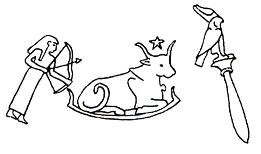 Moving on to the next group of images we see the Sothis Cow, the well-known Egyptian star figure that corresponds to Sirius. She is flanked by two figures unknown outside the Dendera Zodiacs – a female archer and a perching hawk.
Moving on to the next group of images we see the Sothis Cow, the well-known Egyptian star figure that corresponds to Sirius. She is flanked by two figures unknown outside the Dendera Zodiacs – a female archer and a perching hawk.
On the Babylonian star-map the stars of Canis Major, which include Sirius, are referred to as the Bow and Arrow. We can be quite certain that the Babylonian star figure was depicted as a female archer, modelled on the warrior goddess Inanna. The Arrow was treated as a separate constellation associated with the god Ninurta, who combined the roles of warrior and farmer; one of his symbols from entitlement stones is known to be a perched bird. Once again a close correspondence can be seen between the Dendera images and what we know of the Babylonian constellations.
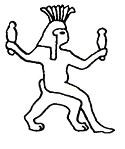 Behind the Sirian group of symbols, we find the figure of an enthroned goddess holding a pair of vases aloft. On the Square Zodiac streams of water can be seen flowing from her vases.
Behind the Sirian group of symbols, we find the figure of an enthroned goddess holding a pair of vases aloft. On the Square Zodiac streams of water can be seen flowing from her vases.
This is, arguably, a depiction of the Babylonian constellation called the Star of Eridu. Although we have little direct knowledge concerning its celestial image, we do know that it was held sacred to Enki, the wise god of the waters, who lived in the freshwater Abyss below the earth. Enki’s sacred city of Eridu, after which the star was named, was reputedly the oldest city in the world. It was located in the southern marshlands of Mesopotamia, and was the site of his principle temple – ‘the House of the Abyss’, which was built on an island set in the midst of a lagoon.
The Star of Eridu obviously has very strong associations to water, a fact that may have led it to become closely allied to the Great One, our Aquarius, in Babylonian astrology. The linkage is so strong that there is reason to believe that both constellations were depicted in a similar manner – as human figures holding overflowing vases. As such the Dendera figure is very compatible with what we know concerning the Star of Eridu. We should also add that the Greek constellation of Eridanus, which obviously derives its name from the Babylonian figure, was depicted among the stars as a winding river.
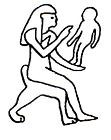 Moving on to the next Dendera figure, we see another enthroned goddess, this time nurturing a young child.
Moving on to the next Dendera figure, we see another enthroned goddess, this time nurturing a young child.
On the Babylonian star-map the constellation of Ninmah is located behind the Star of Eridu. Ninmah, the ‘Exalted Lady’, is closely associated with mankind in general and with children in particular. She appears in creation mythology where she is involved in creating mankind and setting his destiny. For these reasons she is known as one of the Mother Goddesses. Several other references demonstrate her close affinity to children and babies – an incantation dedicated to her asks her to protect newborn infants and in a Sumerian poem she laments the loss of her own child. Even though we have no information on the appearance of Ninmah’s constellation from Babylonian sources the Dendera image of a goddess nurturing a child has got to be a convincing candidate.
 Behind the goddess and child is the strange figure of a bull-headed man holding a hoe-like implement. He stands in front of a rectangle decorated with wavy lines – very similar to the rectangle located between the Piscean fish.
Behind the goddess and child is the strange figure of a bull-headed man holding a hoe-like implement. He stands in front of a rectangle decorated with wavy lines – very similar to the rectangle located between the Piscean fish.
It is very likely that this figure is based on the Babylonian constellation known as the Harrow. It is described in star texts as ‘the weapon of the god Mar-biti’ and that within it is seen a representation of the Abyss – the reservoir of fresh-water found beneath the earth. We have already seen that the rectangle infilled with wavy lines symbolises the watery Abyss in Mesopotamian art. Once again the Dendera imagery and Babylonian star-lore, even though difficult to understand in isolation, throw considerable light on each other when combined.
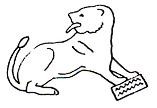 The penultimate figure of this sequence is sometimes described as a lion-like creature, which has its front feet resting on the Abyss symbol. Judging by the surrounding constellations it is very likely to be located in the region of Centaurus.
The penultimate figure of this sequence is sometimes described as a lion-like creature, which has its front feet resting on the Abyss symbol. Judging by the surrounding constellations it is very likely to be located in the region of Centaurus.
In Babylonian tradition this region of the sky is occupied by the Wild Boar; some omen texts even describe it as being located close to the Abyss. In the section on the Wild Boar, I argue that the protruding tongue of the Dendera beast is actually a misunderstanding of the Boar’s tusks and that its mane is similarly a misrepresentation of the Boar’s spinal brush.
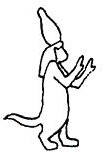 Finally, the strange creature that stands in front of Scorpio can be confidently located among the stars of Lupus. It is depicted as a composite figure made up of human and hippo elements, which wears the white crown of Upper Egypt.
Finally, the strange creature that stands in front of Scorpio can be confidently located among the stars of Lupus. It is depicted as a composite figure made up of human and hippo elements, which wears the white crown of Upper Egypt.
The corresponding Babylonian figure that occupies the stars of Lupus is known as the Mad Dog. It is also a human-beast composite depicted in Neo-Assyrian art as a standing human figure with a lion’s tail and hindquarters, like the Dendera beast it is crowned with a horned headdress that signifies its divine nature (see fig 90).
As can be seen from the preceding comparisons there are some striking parallels between these individual Dendera images and their Babylonian counterparts. That one or two figures should show some resemblance might be put down to chance but what is particularly convincing about this comparison is that it is made up a sequence of 8 or 9 star figures all correctly located in relation to each other. It should also be stressed that beyond the well-known Egyptian figures of Orion and the Sothis Cow, the remaining figures do not occur in Egyptian art outside the Zodiacs at Dendera – this in itself suggests that they have been imported from elsewhere.
The sequence of stars just examined doesn’t exhaust the potential parallels between the Dendera Zodiac and the Babylonian star-map. I would propose that there are at least five more Babylonian constellations depicted with a reasonable degree of clarity on the Circular Zodiac.
 Up in the northern regions of heaven, behind the monstrous figure of the Hippo and Mooring Post, we can see the tiny figures of an enthroned goddess and a dog-like creature – they are very likely to be representations of the well-known Babylonian constellations known as the She-Goat and the Sitting Dog (see fig 123).
Up in the northern regions of heaven, behind the monstrous figure of the Hippo and Mooring Post, we can see the tiny figures of an enthroned goddess and a dog-like creature – they are very likely to be representations of the well-known Babylonian constellations known as the She-Goat and the Sitting Dog (see fig 123).
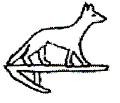 And just the other side of the Hippo, in the circumpolar regions of heaven, is a particularly interesting image of a wolf-like creature set upon a plough. They are, doubtless, an image of the Babylonian constellations known as the Wolf and Plough, which have proved difficult to locate from Babylonian sources alone, so having a clear presentation of their forms is an additional bonus.
And just the other side of the Hippo, in the circumpolar regions of heaven, is a particularly interesting image of a wolf-like creature set upon a plough. They are, doubtless, an image of the Babylonian constellations known as the Wolf and Plough, which have proved difficult to locate from Babylonian sources alone, so having a clear presentation of their forms is an additional bonus.
 Finally, set below the figure of Aries, we have a pair of staff-wielding gods who could well be a representation of the lion-headed Babylonian constellations known as Lulal and Latarak. Like the Wolf and Plough, they have proved difficult to locate on the celestial sphere. Their placement on the Circular Zodiac suggests that they are located among the stars of Cetus.
Finally, set below the figure of Aries, we have a pair of staff-wielding gods who could well be a representation of the lion-headed Babylonian constellations known as Lulal and Latarak. Like the Wolf and Plough, they have proved difficult to locate on the celestial sphere. Their placement on the Circular Zodiac suggests that they are located among the stars of Cetus.
As far as I am aware the close relationship between the Dendera Zodiacs and the Babylonian star-map has not previously been recognised. This is partly due to the relative inaccessibility of information on the Babylonian constellations and the lack of a surviving star-map. The fact that the Dendera figures have been recast in Egyptian iconographic conventions has only made it more difficult to recognise the Babylonian figures.
It is now possible to reconfigure the Circular Zodiac in the light of Babylonian star-lore – the result is displayed below:
The extent to which the Circular Zodiac has been influenced by Babylonian star-lore is amply demonstrated by the figure above, which reconfigures the Circular Zodiac into a more accurate and easily assimilated format. I have rearranged the constellation images to better fit the visible configuration of stars in the sky and have further identified them by their Babylonian names. The planetary figures have also been replaced by their familiar planetary sigils and the handful of native Egyptian figures have been labelled in italics.
In the final analysis, I would argue that the Circular Zodiac is really a rather inaccurate and ‘Egyptianised’ version of the Babylonian star-map with a handful of Egyptian star figures added in or substituted for their Babylonian counterparts. Beyond the cases already examined I would further propose that another nine or ten Babylonian figures are present but have been misunderstood, misplaced or distorted to such an extent that they are actually quite difficult to recognise
Copyright Gavin White, 2007

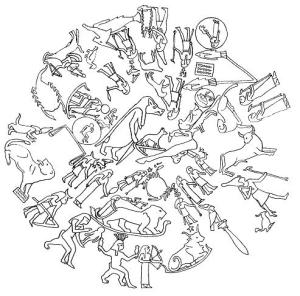
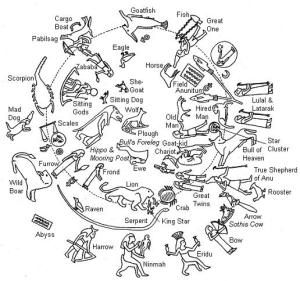
Dear Gavin White,
I have really enjoyed reading your book on the origins of the zodiac and other
constellations. Your descriptions of each sign and the Sumerian/Babylonian
myths behind them deepen the meaning immensely.
I’ve been writing a series of astrological articles for a New Age shop’s
newsletter in the Houston, Texas area. I’ve added the following paragraph to
give you credit and thanks for information on the subject matter. Is this the
proper format? Please let me know if there is anything I should add to credit
your work.
The information on the origins of the astrological signs can be found in the
amazing book, Babylonian Star-Lore by Gavin White. I wish to thank him for his
in-depth, fascinating, and thorough study of an aspect of ancient history that
is just beginning to see the light of the 21st century.
My idea is this: I would like to compile the 12 articles I’ve written each
month for the newsletter into a book tentatively titled “Living the Astrological
Year.” Each sign of the Zodiac would start with the Sumerian/Babylonian
interpretation and corresponding myths, the Egyptian equivalents, then Greek and
Roman. After the historical work, there will be further insights on zodiacal
personalities, then worksheets for readers to write what they experience during
each month of the year.
Yes, this is crazy and ambitious. But like you, I’ve always loved the stories
of the gods and amazed how they are tucked into the lore of the stars. It would
be cool that the tone for such a book that spans thousands of years be personal,
endearing, and even amusing.
I’ve attached my latest article for the newsletter—Capricorn. Remember I just
wrote it this month and is a work in progress. Even though I have a degree in
Creative Writing from UH and have written three novels, this will be my first
non-fiction work.
Could you take a look at the attached newsletter? I would like to use a bit of
your material (paraphrased perhaps) and credit you though I am not sure of the
correct procedure to do so.
If you like to contribute or have any ideas, I will happily consider them.
Thank You Immensely,
Cheryl DuCoin
Hi Cheryl, thank you for your mail. Yes you are welcome to use any relevant information from the book – if you just credit that that will be fine. One point about Capricorn – the translaion of its name should just be ‘the goat-fish’ or the ‘goat-carp’ – I made a slight misinterpretation of the signs in its name!!!
Good luck with your venture. All the best, Gavin at Solaria.
Gavin,
Thank you so much for writing me back. Could you take a look at one article and tell me what you think? Am I on track? This concerns Aquarius and will be in a newsletter coming next month.
AQUARIUS
The Great Friend
Cheryl DuCoin
cherylducoin@cebridge.net
The days between January 21st to February 19th are one of the most wild and wackiest days, yet they are so romantic. Ground Hog day is February 2nd and Mardi Gras sparks off a riotous revelry. Somewhere mixed in the madness comes the romance of Valentine’s Day. What is it that makes Aquarius, The Water Bearer, a time of social pleasures and fantasies?
Aquarius was one of the four original Neolithic constellations that marked the seasons. Because of the progression of the Earth’s axis, later Mesopotamian astronomers saw it in the same spot a month later and marked it as the rainy season and time to irrigate crops.
In ancient Sumeria, Aquarius was called The Great One, Gula. Clay tablets were found imprinted cup and cuneiform for wealth and plenty. Gula was shown holding a jar with two streams of water flowing from it. Later astrologers/priests associated him with the god Enki (Ea) whose father was fresh water and mother was sea water. Enki lived deep underground and produced the springs of the Tigris and Euphrates Rivers. After a great battle between the gods, he mixed their leader’s blood with clay and fashioned the first man, Adapa.
One day as Adapa was fishing, Ninlil, the South Wind, overturned his boat. Furious, Adapa broke his airy wings. The gods called him up to heaven to apologize for maiming a god. While there, his good friend and creator, Enki, warned him not to eat or drink during his heavenly stay. Unfortunately, the king of the gods offered Adapa the food of immortality which Adapa refused, believing it poisoned, thereby missing mankind’s chance for eternal life.
Later, Adapa, created by a god and enlightened by a trip to heaven, brought civilization and the arts to the King of Eridu. Archeologists have excavated the Iraqi town of Eridu and found temples with ancient ponds with mounds in the center. From this evidence, ancient people were thanking watery Enki for making the wise Adapa.
Capricorn was called Suhurmasku and depicted Enki as the Goatfish that brought the sun out of deep water at the winter solstice. Aquarius is the original sign of Enki but set a month later after the pole progression. He represented his blessings of creating man and the arts and bringing water to the earth for irrigation.
The Egyptians also revered the God of the Arts, Ptah, whose name Ta-tenen meant submerged land or mound surrounded by water. Because he crafted the world, he was revered by artisans. Another Egyptian god was Khnum who like Gula, controlled a great river—the Nile. Khnum lived in a cavern at its source and carefully measured the silt that was deposited by the flood. He was the patron of Khufu (Cheops), the pharaoh who built the Great Pyramid. Also like Gula, Khnum created humans from river clay. Like Enki, his body was part goat or sheep and was sometimes drawn holding a cup with flowing water.
It’s interesting that our Groundhog Day is celebrated on the same day as the Egyptian Birthday of Nut—the goddess of night. With her husband, Geb, the God of Earth, she bore Isis and Osiris. She protected her grandson, Horus (Ra) so that he would be born again. Today, we watch a groundhog on TV emerge from his hole to predict if we will see the sun return. It’s the wackiest image—serious men in tails and top hats holding a giant squirming rodent. It was probably a rollicking time in Egypt, too—a time of festivities to welcome the returning sun.
The Greek version of Aquarius starred Ganymede, the most beautiful young man in the world. He was abducted by Zeus in the form of an eagle. Zeus set him up in the posh job of being the cup bearer of the Gods. One Olympian was not pleased—Hera. She became jealous of young Ganymede so Zeus, knowing what kind of insane tragedy could befall his young pal, set him in the sky as Aquarius.
The Greeks celebrated the marriage of Zeus and Hera during the month of Gamelian which is the time of mid January to February. Later Romans celebrated the days of February 13-15 as Lupercalia. Priests represented Faunus, who lived in the cave with babies Romulus and Remus while their “mother,” a wolf, suckled them. After the priests sacrificed a goat and a dog, they skinned them, ran around town naked in the skins, and whipped young woman lining the roads who wished to bear children without suffering.
I think OUR Valentine’s Day is much improved. 🙂
Mardi Gras is a wild and crazy time to let it all out before Ash Wednesday. The latter is the beginning of Lent—a time of repentance and mourning. Catholic Priests dab ashes on believers and recite, “Remember that thou art dust and to dust return.”
The ruler of Aquarius was once stern Saturn which doesn’t suit this sign at all! In 1781, Sir William Herschel found that a star moved more like a planet and named it after the sky god. In the myth, Uranus came every night to sleep with Gaia (Earth). But after his kid, Cronus, ambushed and castrated him, he didn’t really feel the need anymore and kept to his heavenly place.
Uranus is the only planet name not Greek—it’s Roman. Also it’s a bizarre one. Uranus has no perceivable features like all of the other planets. It’s a cold world of eerie blue gasses and wackily rotates on its side with one pole facing the sun.
Perfect to rule a sign famous for being the model of eccentricity!
Famous Aquarian wackies are/were comedians John Belushi, Dick Martin, Carol and Stockard Channing, Harvey Korman, Jack Lemmon, and Ellen Degeneres. But there’s always something sweet and sentimental about their silliness.
Maybe it started with Gula who fashioned the first man and became his good friend. Adapa lived with the gods and brought fine art and class to mankind. Like him, Aquarians combine a beautiful, artful finesse with their quirkiness like Zsa Zsa Gabor, Lana Turner, and Kim Novak (Think Bell, Book, and Candle). Aquarian leading men are/were the ultimate handsome, renegade romantics: Paul Newman, Tom Selleck, Clark Gable, Fabian, James Dean, Burt Reynolds.
Jane Seymour is also a perfect, charming Aquarian who as the gorgeous Solitaire in Live and Let Die could read the future in the cards. They can see beyond the present are ALWAYS inventing or doing something to save the world. In Casablanca, Aquarian Humphrey Bogart lets the love of his life go to help a man who will end a world war. He wistfully utters a wonderful Aquarian sentiment in the last line: “Louis, I think this is the beginning of a beautiful friendship.”
Another perfect Aquarian moment was filmed when Aquarian Ronald Coleman spoke so beautifully—like many born in February—the words of Aquarian Charles Dickens. At the end of A Tale of Two Cities, Sidney Carton takes the place of a friend at a guillotine and says, “It is a far, far better thing that I do, than I have ever done; it is a far, far better rest that I go to than I have ever known.”
Paragraphs before that, Sidney Carton/Charles Dickens foretells a happy Utopian future:
“I see the lives for which I lay down my life, peaceful, useful, prosperous and happy, in that England which I shall see no more. I see Her with a child upon her bosom, who bears my name. I see her father, aged and bent, but otherwise restored, and faithful to all men in his healing office, and at peace. I see the good old man, so long their friend, in ten years’ time enriching them with all he has, and passing tranquilly to his reward.
Many Aquarian utopians rebel against the present system like writers Boris Pasternak, James Joyce, Sinclair Lewis, and Anton Chekov. Or feminists Colette, Virginia Woolf, Germaine Greer, Betty Friedan, and Helen Gurly Brown.
They are compelled to tear down then invent a new world. Aquarian politicians were: Abraham Lincoln, FDR, and Ronald Reagan. They love to revel in fantasies and write new worlds like Vules Verne, Charles Darwin, and Lewis Carroll. Or they could discover one like Amerigo Vespucci.
Many express their Air Sign qualities perfectly and take to the sky like Charles Lindbergh, and astronauts Edwin Aldin, and Roger Chaffee. (Hmm, they discovered new worlds, too!)
Great jobs for Aquarians include computers and high-tech, aeronautics, social work (Aquarius rules the astral chart’s eleventh house of friends and social groups), and anything that requires eloquent writing and speaking.
They are dreamers, but love being involved in groups. They’re super-friendly. In love this might not be so cool. When everybody’s your friend, how could anyone be “special?”
Aquarius/February’s traditional birthstone is amethyst. But I believe this intensely violet stone is too deeply psychic and more suited to Pisces. Amethyst agate is a better representative for Aquarius. Its undulating bands suggest outgoing movement like the convection of Air, yet the amethyst brings a touch of insightfulness. Lavender and blue agate are great, too. So are other lavender and blue stones: aquamarine, topaz, tanzanite, and labradorite (sparkling, insightful personality), apatite, and lapis lazuli that resembles a blue night sky filled with friendly stars.
Wear these fantasy gems if you want to accentuate your Airy, Aquarius side. You may have one and not even know it. Find out if the sun, moon, or planets are in this sign or if you have activity in your eleventh house.
The information on the origins of the astrological signs can be found in the amazing book, Babylonian Star-Lore by Gavin White. I thank him for his in-depth, fascinating, and thorough study of an aspect of ancient history that is just beginning to see the light of the 21st century.
hi
do i understand you have astrological interpretations of egyption astrology,if so,how can i learn more,there are a few potboilerish sites ,but nothing studios and psychologically sound.
thanks
anna
Hi Anna, no I don’t have anything on Egyptian astrology. I have only explored the visual aspects of the astronomic monuments. A good place to start might be
http://www.astrologyweekly.com/forum/archive/index.php/t-44736.html
This forum post includes a recommended reading list. The author himself might help you further. We have exchanged the occasional email – he is sound and knowlegable and generally willing to help
Hope this helps, Gavin
Gavin, are you working on another writing project right now?
Hi Cheryl, I’m putting together an introduction to the Sumerian signs. Gavin
Hi Gavin – I love this article and want to post it on my site, Stargazer’s Journal. Right now I’m doing a series on more contemporary concerns (mundane astrology etc.) but I was planning on doing some work on Babylonian mythology and astrology in a few months, and I know some of my readers and followers would just love this piece. I think it may get you a few more readers. BTW – I do have a copy of your book (Star-Lore) and it is simply wonderful.
Thanks,
Roy
Hi Roy, you are welcome to post the ‘New Interpretation of the Dendera Zodiac’ article on your site. All that I ask is that you please reference the book rather than the web-site. Cheers Gavin at Solaria
Gavin, I can’t seem to find the icon marked ‘star cluster’ here on any other image of the Denderah Sky Map. Where did you come across this figure?
Hi Sage, the Eye-symbol gets moved in the reconfiguration. In both maps, it is set behind the Ram of Aries. I interpret it as a symbol of the Pleiades, the warlike gods of the Star Cluster. However, many other commentators have other ideas. The issue is difficult as the springtime constellations – Aries and Taurus – are both reversed left to right.
Hope this helps, Gavin
With your reconfigured map it could have been the Pleiades, but as it’s not represented that way by it’s creators I don’t think I could accept that. Are you making the connection between Krittikas (Warrior Son) of India with that of Horus (Warrior Son) of Egypt? Are you aware that the Eye of Horus was a measurement icon? It’s placement between the ‘last’ sign (Pisces) and the ‘first’ sign (Aries) corresponds to Meshadi in Jyothis (Vedic Indian tradition), which marks the point to begin measuring sidereal planetary longitudes. It’s placement in its original position may not intend the Pleiades.
Thanks for your response.
Sage
Hi Sage, I have sent an email to your listed address. Hope you got it. Gavin
Thank you Gavin. I’ve sent you somewhat lengthy response. I wanted to add: “The Yavanas say that the Supreme Eye is the observed course of the heaven” which comes directly from the Yavana Jataka Rules of Horoscopy (a Vedic text interpreted as ‘Sayings/Teachings of the Greeks’).
Sage
Reblogged this on Anthony Louis – Astrology & Tarot Blog.
Reblogged this on Subspace Radio Signals.
Reblogged this on Grandtrines and commented:
Really rather interesting. Starts to fill in certain gaps (notably the Leo/Virgo relationship and the Aquarius/Pisces relationship).
Pingback: Sunngiht – Mythisch Lokeren
Pingback: Mutual delight – Sabine shares